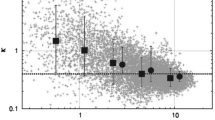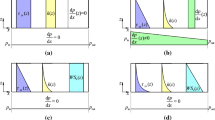Summary
The atmospheric boundary layer in an ana-cold front and in a kata-cold front is investigated using measurements at a 200 m high tower near Karlsruhe, Germany. In the ana-cold front the wind speed decreased, whereas the passage of the kata-cold front was accompanied by strong gusts. The frontogenesis function of potential temperature was only weak. Turbulence increased at the fronts as expressed by the turbulent kinetic energy. However, the turbulent vertical momentum flux was relatively inefficient at the passage of the fronts. Also it is attempted to calculated flux profiles and friction in the cold air.
Similar content being viewed by others
References
Adrian, G., Fiedler, F., 1991: Simulation of unstationary wind and temperature fields over complex terrain and comparison with observations.Beitr. Phys. Atmos.,64, 27–48.
Ball, F. K., 1960: A theory of fronts in relation to surface stress.Quart. J. Roy. Meteor. Soc.,86, 51–66.
Bergeron, T., 1937: On the physics of fronts.Bull. Amer. Meteor. Soc.,18, 265–275.
Blackadar, A. K., 1962: The vertical distribution of wind and turbulent exchange in a neutral atmosphere.J. Geophys. Res.,67, 3095–3102.
Browning, K. A., Harrold, T. W., 1970: Air motion and precipitation growth at a cold front.Quart. J. Roy. Meteor. Soc.,96, 369–389.
Browning, K. A., Pardoe, C. W., 1973: Structure of low-level jet streams ahead of mid-latitude cold fronts.Quart. J. Roy. Meteor. Soc.,99, 619–638.
Brümmer, B., 1988: Structure and circulation in the boundary layer at a strong cold front.Beitr. Phys. Atmos.,61, 232–243.
Businger, J. A., Wyngaard, J. C., Izumi, Y., Bradley, E. F., 1971: Flux-profile relationships in the atmospheric surface layer.J. Atmos. Sci.,28, 181–189.
Caughey, S. J., Palmer, S. G., 1979: Some aspects of turbulence structure through the depth of the convective boundary layer.Quart. J. Roy. Meteor. Soc.,105, 811–827.
Charba, J., 1974: Application of gravity current model to analysis of squall-line gust front.Mon. Wea. Rev.,102, 140–156.
Clarke, R. H., 1961: Mesostructure of dry cold fronts over featureless terrain.J. Meteor.,18, 715–735.
Deardorff, J. W., 1947a: Three-dimensional numerical study of the height and mean structure of a heated planetary boundary layer.Bound.-Layer Meteor.,7, 81–106.
Deardorff, J. W., 1974b: Three-dimensional numerical study of turbulence in an entraining mixed layer.Bound.-Layer Meteor.,7, 199–226.
Dyer, A. J., 1974: A review of flux-profile relationships.Bound.-Layer Meteor.,7, 363–372.
Fiedler, F., 1972: The effect of baroclinicity on the resistance law in a diabatic Ekman layer.Beitr. Phys. Atmos.,45, 164–173.
Grant, A. L. M., 1986: Observations of boundary layer structure made during the 1982 KONTUR experiment.Quart. J. Roy. Meteor. Soc.,112, 825–841.
Hafner, T., 1981: Turbulenzstrukturen in der atmosphärischen Grenzschicht abgeleitet aus den Varianzen der Windgeschwindigkeitskomponenten. Diplomarbeit, Meteorolog. Inst. Univ. Karlsruhe, 143 pp.
Harsha, P. T., 1977: Kinetic energy methods. In: Frost W., Moulden, T. H. (eds.)Handbook of Turbulence, Vol. 1. New York, London: Plenum Press, 187–235.
Hobbs, P. V., Persson, P. O. G., 1982: The mesoscale and microscale structure and organization of clouds and precipitation in midlatitude cyclones. Part V: The substructure of narrow cold-frontal rainbands.J. Atmos. Sci.,39, 280–295.
Hoinka, K. P., 1985: On fronts in central Europe.Beitr. Phys. Atmos.,58, 560–571.
Hoinka, K. P., Volkert, H., 1987: The German Front Experiment 1987.Bull. Amer. Meteor. Soc.,68, 1424–1427.
Hoinka, K. P., Volkert, H., 1992: Fronts and the Alps: Findings from the Front Experiment 1987.Meteorol. Atmos. Phys.,48, 51–75.
Hoinka, K. P., Volkert, H., Heimann, D., 1988: The German Front Experiment 1987: Observations and preliminary results. Research Report, DFVLR-FB 88-21, 133 pp.
Hoskins, B. J., 1982: The mathematical theory of frontogenesis.Ann. Rev. Fluid Mech.,14, 131–151.
Kaimal, J. C., Wyngaard, J. C., Haugen, D. A., Coté, O. R., Izumi, Y., Caughey, S. J., Readings, J. C., 1976: Turbulence structure in the convective boundary layer.J. Atmos. Sci.,33, 2152–2169.
Kraus, H., 1992: Turbulence frontogenesis.Meteorol. Atmos. Phys.,48, 309–315.
Kurz, M., 1988: Vorläufige Untersuchungsergebnisse zur dritten und vierten Meßkampagne. Frontenexperiment innerhalb des DFG-Projekts “Fronten und Orographie”. Offenbach: Deutscher Wetterdienst, 19 pp.
Kurz, M., 1990: The influence of the Alps on structure and behaviour of cold fronts over southern Germany.Meteorol. Atmos. Phys.,43, 61–68.
Lenschow, D. H., Wyngaard, J. C., Pennel, W. T., 1980: Mean-field and second moment budgets in a baroclinic, convective boundary layer.J. Atmos. Sci.,37, 1313–1326.
Miller, J. E., 1948: On the concept of frontogenesis.J. Meteor.,5, 169–171.
Monin, A. S., Obukhov, A. M., 1958: Fundamentale Gesetzmäßigkeiten der turbulenten Vermischung in der bodennahen Atmosphäre. In: Goering, H., (ed.)Statistische Theorie der Turbulenz. Berlin: Akad. Verlag, 199–226.
Panofsky, H. A., Dutton, J. A., 1984:Atmospheric Turbulence, Models and Methods for Engineering Applications. New York: John Wiley & Sons, 397 pp.
Panofsky, H. A., Tennekes, H., Lenschow, D. H., Wyngaard, J. C., 1977: The characteristics of turbulent velocity components in the surface layer under convective conditions.Bound.-Layer Meteor.,11, 355–361.
Peterson, E. W., 1969: Modification of mean flow and turbulent energy by a change in surface roughness under conditions of neutral stability.Quart. J. Roy. Meteor. Soc.,95, 561–575.
Priestley, C. H. B., 1967: Handover in scale of the fluxes of momentum, heat, etc. in the atmospheric boundary layer.Phys. Fluids Supplement, S38–S46.
Sansom, H. W., 1951: A study of cold fronts over the British Isles.Quart. J. Roy. Meteor. Soc.,77, 96–120.
Shapiro, M. A., 1984: Meteorological tower measurements of a surface cold front.Mon. Wea. Rev.,112, 1634–1639.
Shir, C. C., 1972: A numerical computation of air flow over a sudden change of surface roughness.J. Atmos. Sci.,29, 304–310.
Stull, R. B., 1988:An Introduction to Boundary Layer Meteorology. Atmospheric Sciences Library, Dordrecht: Kluwer Academic Publ., 666 pp.
Yaglom, A. M., 1977: Comments on wind and temperature flux profile relationships.Bound.-Layer Meteor.,11, 89–102.
Young, G. S., Johnson, R. H., 1984: Meso- and microscale features of a Colorado cold front.J. Climate Appl. Meteor 23, 1315–1325.
Author information
Authors and Affiliations
Additional information
With 15 Figures
Rights and permissions
About this article
Cite this article
Frank, H.P. Boundary layer structure in two fronts passing a tower. Meteorl. Atmos. Phys. 53, 95–109 (1994). https://doi.org/10.1007/BF01031907
Received:
Revised:
Issue Date:
DOI: https://doi.org/10.1007/BF01031907




